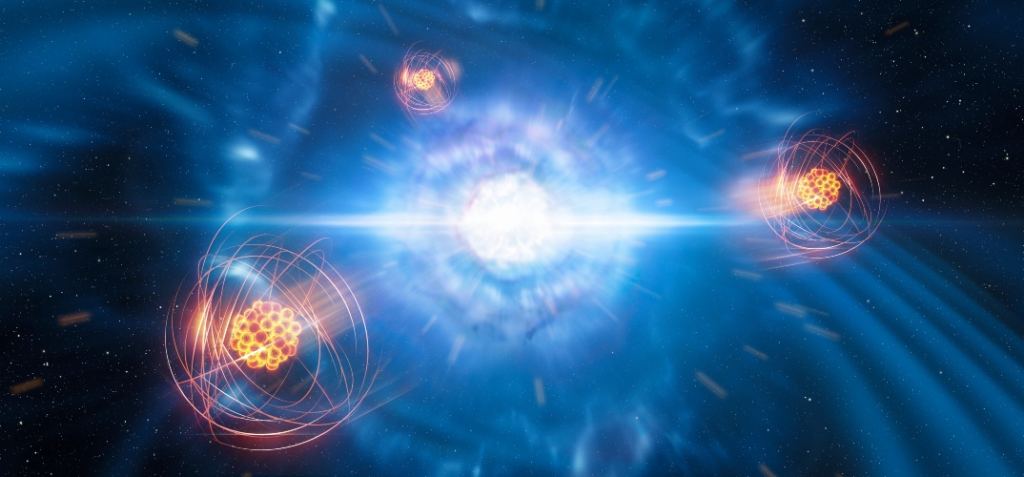When stars die, they spread the elements they’ve created in their cores out to space. But, other objects and processes in space also create elements. Eventually, that “star stuff” scatters across the galaxy in giant debris clouds.
Later on—sometimes millions of years later—it settles onto planets. What’s the missing link between element creation and deposition on some distant world? That’s the question researchers asked themselves for years as they tried to figure out how heavy elements like manganese, iron, and plutonium showed up on Earth. It turns out they’re made in different processes, often in different parts of the Milky Way.
Yet, they’ve been found layered together on Earth’s seabed. That implies they arrived about the same time, despite their different origins. Scientists from the University of Hertfordshire in the UK and the Konkoly Observatory, Research Centre for Astronomy and Earth Sciences in Hungary put together some theories and computer models to simulate how elements travel through space.
The answer they came up with: the elements from faraway events are carried by supernova shock fronts just like surfers catching a wave. Remove All Ads on Universe Today Join our Patreon for as little as $3! Get the ad-free experience for life To understand how stuff from distant conflagrations ended up on Earth, it’s worth taking a quick look at those events. First, there are the Type II supernovae.
They occur when a supermassive star dies. That’s one at least eight times the mass of the Sun. These stars fuse heavier and heavier elements (such as carbon) in their cores.
When they get to creating iron, they don’t have enough energy to keep up the production line. The cores collapse and then everything expands outward very rapidly in a supernova explosion. That’s enough to send its heavy elements racing through space.
Next, there are Type Ia supernovae. These happen in a binary pair of stars. Material from a main-sequence star accretes onto its partner, a white dwarf.
When too much material accumulates, there’s an explosion. That results in the “nucleosynthesis” of heavier elements, including manganese. Another catastrophic event that likely creates heavy elements is the collision (or merger) of two neutron stars .
As they spiral in toward each other and eventually smash up, they release a shower of neutrons. Those, in turn, bombard nearby atoms. This “r-process” event very quickly produces heavy elements such as plutonium.
Somehow, all this material from different sources ended up on Earth at about the same time. Scientists found puzzling evidence of that in radioactive isotope deposits on the seabed in 2021. They weren’t formed normally on Earth or during the birth of the solar system some 4.
5 billion years ago. They had to come from somewhere else. For the resulting “star stuff” to end up on any world in any star system, there needs to be a consistent galaxy-wide delivery service.
This concept intrigued Dr. Chiaki Kobayaski from the University of Hertfordshire, who said, “I have been working on the origins of stable elements in the periodic table for many years, but I am thrilled to achieve results on radioactive isotopes in this paper. Their abundance can be measured by gamma-ray telescopes in space as well as by digging the rocks underwater of the Earth.
” The rocks Kobayashi refers to came from the underwater exploration of Earth’s oceans, according to study leader Benjamin Wehmeyer. They created computer models showing that nearly continuous supernova shock waves could be a viable transporter mechanism to deliver these elements to Earth (or other planets). “Our colleagues have dug up rock samples from the ocean floor, dissolved them, put them in an accelerator, and examined the changes in their composition layer by layer,” he said.
“Using our computer models, we were able to interpret their data to find out how exactly atoms move throughout the Galaxy. ” The modeling effort shows that isotopes can propagate through large areas of a galaxy via supernova shock waves. These fronts sweep up collections of elements from various sites.
Understanding this delivery process is particularly crucial as astronomers begin large-scale studies of exoplanets where life might be possible. Knowing how they got their elemental composition is a big step toward understanding the possibilities for life. “It’s a very important step forward, as it not only shows us how isotopes propagate through the Galaxy but also how they become abundant on exoplanets—that is, planets beyond our solar system,” said Wehmeyer.
“This is extremely exciting since isotopic abundances are a strong factor in determining whether an exoplanet is able to hold liquid water—which is key to life. In the future, this might help to identify regions in our Galaxy where we could find habitable exoplanets”. Radioactive Isotopes Reach Earth by Surfing Supernova Blast Waves, Scientists Discover Inhomogeneous Enrichment of Radioactive Nuclei in the Galaxy: Deposition of Live 53 Mn, 60 Fe, 182 Hf, and 244 Pu into Deep-sea Archives.
Surfing the Wave? Trace Seabed Plutonium Points to Stellar Forges of Heavy Elements 60 Fe and 244 Pu Deposited on Earth Constrain the R-process Yields of Recent Nearby Supernovae.
From: universetoday
URL: https://www.universetoday.com/160207/some-elements-arrived-on-earth-by-surfing-supernova-shock-waves/



